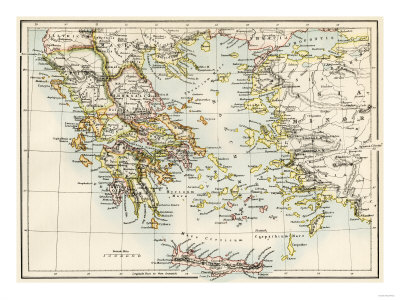Islands in the Aegean Sea

A northern arm of the much larger Mediterranean Sea, the Aegean Sea is sandwiched between the eastern shores of mainland Greece and the western shores of Turkey. Within its reach of 83,000 square miles it hosts thousands of islands and islets, less than 100 of which have more than 100 inhabitants. But within those islands they hold thousands of years of history, culture and spectacular natural beauty.
Part of the Mediterranean climate, the islands in the Aegean Sea reach temperatures in the dry summer in the high 80’s to 90’s, cooling down to the 40’s and 50’s in the wet winter. The surface temperature of the Aegean in the summer ranges from 70 degrees in the north to 80 degrees in the south, making it comfortable for summertime swimming.
Although island-hopping is an enchanting idea, remember that many of these islands are not easy to reach and even the most popular ones require travel time, so it’s generally best to limit your “hops” to islands in relative proximity to each other, or to leverage one of the popular cruises that stops at multiple islands if you want to get a taste of more than one Greek (or Turkish) island without spending your entire trip traveling.
As for those thousands of islands, what differentiates them? The vast majority of the Aegean islands belong to Greece while a small number belong to Turkey. They range in size from the largest, Crete, at over 3,000 sq. mi. down through Delos at only 1.5 sq. mi. to even tinier islets, mostly uninhabited. Below, and in the referenced lists, are snippets about each of the larger and more frequently visited islands in the Aegean.
The two largest islands in the Aegean Sea are the Greek islands of Crete and Euboea. The other Aegean islands are generally divided into 5 geographic areas as described below.
Crete – 3,224 sq. mi.; population 624,000
Forming the southern border of the Aegean Sea, Crete is the largest and most populous of the Greek Islands. Filled with ancient ruins and historical sites, Crete also offers excellent hiking opportunities, especially in the Samaria Gorge, as well as stunning beaches and coves.
Euboea (or Evia) – 1,411 sq. mi.; population 220,000
A long, narrow island separated by the Euripus Strait from the eastern shore of mainland Greece, Euboea is often thought of as part of the mainland itself. From a tourism perspective, it is best known for the thermal hot springs at Edipsos, for the beachside resort at the modern town of Eretria on the site of the ancient city of the same name, still being excavated, and as a weekend seaside getaway for Athenians.
The Sporades
A tight group of islands off the north coast of Euboea, the Sporades incorporate about 30 islands including the main islands of Skiathos, Skopelos, Skyros, and Alonnisus.
Saronic Islands
Located in the Saronic Gulf just off the southeastern coast of mainland Greece near Athens, the Saronic Islands include 31 islands, of which 7 are inhabited – Aegina, Hydra, Poros, Spetses, Angistri, Salamina, and Dokos.
North Aegean Islands
Off the western coast of Turkey at the central to northern end of the Aegean, the North Aegean Islands are a loose group of islands including the Turkish islands of Imbros and Tenedos and the Greek islands of Chios, Icaria, Samos and many more.
The Cyclades
Roughly in the center of the Aegean, north of the Sea of Crete, the Cyclades incorporate over 200 islands, some of the best known of which are Santorini, Mykonos, Delos and Naxos.
The Dodecanese
Along the southeastern edge of the Aegean, bordering Turkey, the Dodecanese Islands incorporate 164 islands of which 26 are inhabited, the most well-known of which are Rhodes and Patmos.
Note: no promotional consideration was provided or paid for this article.
Part of the Mediterranean climate, the islands in the Aegean Sea reach temperatures in the dry summer in the high 80’s to 90’s, cooling down to the 40’s and 50’s in the wet winter. The surface temperature of the Aegean in the summer ranges from 70 degrees in the north to 80 degrees in the south, making it comfortable for summertime swimming.
|
As for those thousands of islands, what differentiates them? The vast majority of the Aegean islands belong to Greece while a small number belong to Turkey. They range in size from the largest, Crete, at over 3,000 sq. mi. down through Delos at only 1.5 sq. mi. to even tinier islets, mostly uninhabited. Below, and in the referenced lists, are snippets about each of the larger and more frequently visited islands in the Aegean.
The two largest islands in the Aegean Sea are the Greek islands of Crete and Euboea. The other Aegean islands are generally divided into 5 geographic areas as described below.
Crete – 3,224 sq. mi.; population 624,000
Forming the southern border of the Aegean Sea, Crete is the largest and most populous of the Greek Islands. Filled with ancient ruins and historical sites, Crete also offers excellent hiking opportunities, especially in the Samaria Gorge, as well as stunning beaches and coves.
Euboea (or Evia) – 1,411 sq. mi.; population 220,000
A long, narrow island separated by the Euripus Strait from the eastern shore of mainland Greece, Euboea is often thought of as part of the mainland itself. From a tourism perspective, it is best known for the thermal hot springs at Edipsos, for the beachside resort at the modern town of Eretria on the site of the ancient city of the same name, still being excavated, and as a weekend seaside getaway for Athenians.
The Sporades
A tight group of islands off the north coast of Euboea, the Sporades incorporate about 30 islands including the main islands of Skiathos, Skopelos, Skyros, and Alonnisus.
Saronic Islands
Located in the Saronic Gulf just off the southeastern coast of mainland Greece near Athens, the Saronic Islands include 31 islands, of which 7 are inhabited – Aegina, Hydra, Poros, Spetses, Angistri, Salamina, and Dokos.
North Aegean Islands
Off the western coast of Turkey at the central to northern end of the Aegean, the North Aegean Islands are a loose group of islands including the Turkish islands of Imbros and Tenedos and the Greek islands of Chios, Icaria, Samos and many more.
The Cyclades
Roughly in the center of the Aegean, north of the Sea of Crete, the Cyclades incorporate over 200 islands, some of the best known of which are Santorini, Mykonos, Delos and Naxos.
The Dodecanese
Along the southeastern edge of the Aegean, bordering Turkey, the Dodecanese Islands incorporate 164 islands of which 26 are inhabited, the most well-known of which are Rhodes and Patmos.
Note: no promotional consideration was provided or paid for this article.

Related Articles
Editor's Picks Articles
Top Ten Articles
Previous Features
Site Map
Content copyright © 2023 by Laura Hartney. All rights reserved.
This content was written by Laura Hartney. If you wish to use this content in any manner, you need written permission. Contact Malika Bowling for details.




